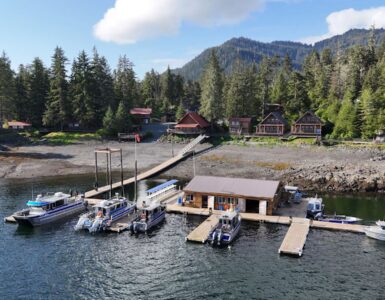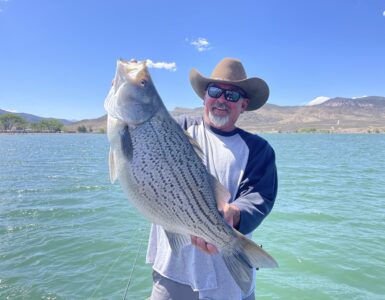Coming up tonight on KSL Outdoors.
We’re snowmobiling into the North Slope of the High Unita’s for some late season ice fishing.
Look at that boy!
Plus…. Outdoors Producer, Jared Hargrave is backcountry skiing the Tushar Mountains and checking out the Puffer Lake yurt.
I am Adam Eakle and this is KSL Outdoors.
KSL Outdoors, with Adam Eakle, is brought to you by your local Ford stores.
Welcome to KSL Outdoors, I’m Adam Eakle. Tonight’s show we are kicking off in Evanston. We are going to take you into the high Unitas and go visit a couple of reservoirs, I’ve never been to. We are going to target some big rainbows and hopefully some tiger trout. Just got to fill our snowmobiles that we got from Valley Recreation and Rental and we are on the road.
Hey Natalie, where are we going? I think we are like somewhere on the North Slope of the Unita’s today and I believe we are going to a place called Longs Park and maybe Spirit lake.
You are right between Manilla and Dutch John. So you find the Sheep Creek geologic loop turn off, and then you are going to take a forest service road from there.
The wintertime is a cool new experience, it ought to be rad!
From the parking lot, it’s about eight miles of easy snowmobiling on a snow packed road to Long Park Reservoir.
On the way you pass the twelve thousand feet Leidy and Marsh peaks. It’s a pretty ride, through aspens and conifers and you can tell no one has been on the trail for days.
a lot bigger than I thought it would be.
This twelve hundred acre reservoir sits at about eighty six hundred feet. It’s literally loaded with rainbows and you also have a chance at a brook or cutthroat trout. Biologists have netted this reservoir in the past year and have seen fish upwards of 20 inches.
Thirty inches of ice. No slush, fine February day.
Jay’s got a fish on!
Not too bad. That’s a sweet rainbow.
that’s a pretty decent fish, we’ve only been here five minutes. Yeah, five minutes and hit pretty good.
First time on the ice this year? Yeah first time on the ice. You are little late! I am a little late. First time and maybe last but it’s always a good time.
There he is. Yeah there you go!
Doesn’t feel very big, but it’s the first one of the day, see what we’ve got.
Oh pretty rainbow, nice fish. That’s a good one.
Boy just a beautiful fish, just a nice 17, maybe 16-17 inch fish, got some beautiful colors
on him. Check out that. That is some of the prettier rainbows you’ll see. Oh we’ve got another bite.
Oh yeah this is a good one. Look at this one.
Look at that boy. Nice one Jay.
Same jig isn’t it? Yeah same one.
Look at that. Beautiful mouth. what a beautiful fish, pretty fish, let him go.
These are usually pretty handy, dandy power tubes.
Pink seemed to be the color today as everyone was catching fish.
I switched over to the pink power tube.
Little rainbow. Well, he’ll grow into this nice big ones, right?
Oh they finally bit the Hali rig, it was worth it.
I got the trophy! Like Clint said, it’s not that easy to catch the smallest fish.
Well, it’s quality fishing and in this case we have quality fish.
Not too bad.
A couple of weeks ago I was up here and caught some that were pushing 20 inches. Some nice rainbows and in our netting surveys we got brookies that were pushing 18 inches as well. So it’s really quality fishing. I mean this is gorgeous scenery. We are sitting on the North Slope of the Unitas.
Oh that’s not a bad fish.
The other allure though is getting away from the crowds. It’s obvious that nobody has been here for probably three days at least.
Lots of little guys like that running around.
The allure to me is getting out and enjoying it and getting remote.
Oh the other one! That one there! He’s got a double! I’m glad it’s your pole and you got the big one at least man.
Coming up next on KSL Outdoors we take a look at a project biologists have been working on to restore native cutthroat populations to the area, plus.
It’s awesome skiing, I mean we didn’t see any other ski tracks.
Back country skiing the Tushars while enjoying the warmth of a Mongolian style yurt. But first let’s dive into tonight’s Burt Brothers quiz question.
Long Park Reservoir is located within the 1.3 million acre Ashley National Forest. The history of the Ashley National Forest is as colorful as the people who first inhabited the area. From Native Americans, European trappers, explorers, settlers even outlaws. Our Burt Brothers quiz question tonight is. Who is the Ashely National Forest named after? The answer when KSL Outdoors, powered by Ford returns to the high Unitas.
Welcome back to KSL Outdoors, back here in North Slope of the high Unita’s, I’m Adam Eakle. Hey in a moment we are going to try a different lake for a different species, but first tonight’s answer to our Burt Brothers quiz question.
And our question tonight is. Who is the Ashely National Forest named after? Here’s the answer. In 1825 General William Henry Ashley, co-owner of the Rocky Mountain fur company explored the Green River and the Unita Mountains in search of beaver pelts. Ashley devised the rendezvous system in which trappers, Indians and traders would meet annually to exchange furs, goods and money. His innovations in the fur trade earned Ashley a great deal of recognition, and this is who the Ashley National Forest is named after.
We are at Spirit Lake. It was part of the Middle Fork, Sheep Creek treatment for cutthroat trout.
Nationally there has been a big push to bring native fish species back to their historic range. In Utah, it’s no different. The DWR and others have has been working for decades on Bonneville, Yellowstone and Colorado River Cutthroat trout restoration programs. The Sheep Creek drainage was one place the Colorado River Cutthroat trout used to thrive.
So, in 2012 and 2013, biologists began the process of removing non-native fishes in the streams and lakes of the Sheep Creek drainage and restocking genetically pure Colorado River Cutthroat trout.
So we did a collection of cutthroat from the north fork with backpack electro fishers. We had some pretty big crews.
Then we’d store those fish in some live containers in the spring and then we’d haul those out. We hauled a batch to the Middle Fork using horses with Alex’s help. The UHP helicopter in one day and we flew them over the mountain to another lake we are putting them in now.
It’s just a huge restoration project for cutthroat on this whole north slope.
In the 1990’s, a decline in the Colorado River Cutthroat trout’s historic range led some to petition the U.S. Fish and Wildlife Service to protect the trout under the Endangered Species Act. It was determined that the fish didn’t warrant a listing, in part because of the actions of our DWR to restore the trout to it’s natural waters.
They’ve been petitioned twice that I know of to actually be listed so if they are listed that takes that management authority away from us and places it in the hands of the Fish and Wildlife Service.
If stuff goes on the endangered species list it’s a whole other world in what you have to do to be able to recreate, fish, everything.
And that’s what this whole program in the NE Region was created for. There’s been massive projects, North Slope, South Slope and in the Lake Canyon area just trying to preserve, protect, enhance, everything that we can do.
It is going to take some time for the DWR to develop a brood source of these Colorado River Cutthroat trout to populate more waters on the North Slope. In the meantime.
There’s a decent one. There’s a tiger.
The sterile tiger trout was stocked to give anglers an opportunity to catch some fish.
He’s not very big.
And speaking of catching fish. A few weeks ago we told you about plans to hold a Cutthroat Slam here in Utah that will start up April 1st. What you have to do is catch all four species of native cutthroat trout found in Utah in their native ranges. The Colorado River Cutthroat trout in the Sheep Creek drainage would satisfy one species requirement.
To me the importance of the cutt slam is big time from an education and outreach perspective
There he is.
Of getting people to realize the importance of the resource that are native to our state. I mean it’s part of our heritage when you look at it.
Honestly from a fly fisherman perspective, my own. I prefer to go after cutthroat trout because they are more apt to bite and in most cases we’ll get equal growth out of cutthroat trout versus a brook trout.
I’ve done the Wyoming cutt slam and I can’t wait to do the Nevada one. It’s enticing for me to go and do that type of thing.
Boy the fish were a lot bigger and the fishing a lot faster at Long Park than it was up here at Spirit Lake but you can’t beat the beauty here at ten thousand feet. And hey if you do catch any of those cutthroat trout, biologists are asking that release those Colorado cutts so they can try and get established here in the drainage. Time now to head back to the guys at Fish Tech for tonight’s Fishing Report.
Hi, I’m Dan Smith from Fish Tech Outfitters. I get questions about sinkers and how they are used, is this the right sinker for the right situation. Probably the number one sinker is the split shot. That is used probably 90% of the time, you want to put just a little extra weight on a spinner or something. Drop shot weights, that’s for on the bottom of you line. You have your hook coming out above the sinker. The trolling sinker which is the banana sinker. So you tie your line on this end and then you put a leader to whatever you are trolling like a flatfish or a Rapala. You’ve got a bullet weight. That’s for plastic worms where it goes right up on the nose of the worm. Then you’ve got slip sinkers. You’ve got a flat round one, eggs sinker, you’ve got a bass sinker and then you’ve got a great big heavy ball sinker. Then there is the bell sinker. A lot of guys sturgeon fishing use these. They’ll put it on a three way and drop a line down to it. So this line is a little bit less poundage than the main line so if you get snagged you can break it off. If you have any questions on the proper sinker for the proper application. Come on down to Fish Tech and we’ll help you out. Now for tonight’s fishing line.
Welcome back to KSL Outdoors, I’m Jared Hargrave. You know, as a backcountry skier, the Wasatch Mountains are pretty spectacular. But the winter is not complete unless you go on a backcountry yurt trip. We’re hanging out at the Puffer Lake Yurt in the Tushar Mountains above Beaver, Utah, making turns in high alpine bowls and cold snow in the trees.
We’re about to skin up to the Puffer Lake Yurt. A nice balmy day here in the Tushar Mountains.
The yurt is located below the eleven thousand-foot summit of City Creek Peak. It’s only a two-and-a-half mile hike… on a pretty well packed road through some beautiful scenery.
And we make it to the yurt before noon.
We try to keep the yurt stocked with amenities such as, you know, bunk beds, we have sleeping pads here in the yurts. We also have a stove and little wood stoves for heat.
After checking our avalanche beacons, we skin up City Creek Peak to see what we can ski.
You don’t have to stray very far to get good runs here, especially when you’re already at this high elevation. It wasn’t much work to find good turns.
Ski terrain is pretty nice, we’ve got a lot of mellow tree runs, a lot of low angle slopes. And then we’ve got a lot of bigger stuff back further in the backcountry.
We got about six inches over the weekend, so we got some nice powder runs and some nice corn skiing.
I was a little skeptical. I think we tend to be a little snobby with the Wasatch. We assume the snow can’t be better anywhere else. The fact of the matter is that if there’s snow and you can turn in it, I still have a good time in it and this snow turned out much better than I expected.
There is kind of that rustic simplicity of getting back from skiing and then getting to work. Doing the chores. Chop wood. We’ve got to get out here and get snowmelt for water. Prepare our meals, and get a fire going. Chop wood.
It is such a novel experience really to be doing this and sort of be removed from civilization even for a few days.
That’s where we skied yesterday.
From the summit, down the ridge, took this chute down, it was uh, good corn snow.
And we did a bunch of the backside of the mountain. It was good powder in the morning and then it warms up and we have some good corn skiing the rest of the day.
The terrain is really good. It’s not too steep, pretty easy to skin up on any of these hills, and beautiful views. Luckily we got some good sunshine and incredible views in all directions.
Any time you’re out with friends skiing, you’re pretty much guaranteed no matter what happens, no matter what doesn’t turn out the way you planned, you’re still having a good time because you’re on skis. It’s better than working. And you’re with friends.
To book your own yurt trip to the Tushar Mountains, check them out online at SkiTushar.com. Now let’s send it back to Adam for this week’s Utah Field Guide.
Did you know that back country skiing is one of the fastest growing snow sports in the world? I didn’t. It just so happens that Outdoors producer Jared Hargrave just finished a book with ninety nine routes all over Utah. It took you a long time.
Yeah it took me about three seasons of non-stop research every single weekend.
Yeah tell me about the book.
I’ve looked through and I know it’s from North to South, East to West, every big range in Utah. There is ninety nine routes in the book from the Bear Rivers to the Wasatch, to the Oquirrihs, the LaSals, the Tushars, the Henry’s, the Abajo’s, pretty much every major mountain range in Utah.
Your book is really specific in that you can drive and then walk to all these routes right. Yeah they are all day tours pretty much so from the time you park your car at the trail head you can ski the route and be in your car before dark.
You skied every one of these. I did ski every route in this book and I’d say wife Callista is a saint for letting me do it for three seasons. I was never home.
I’ll bet and where can people find it?
This book is available on Amazon.com, Barnes and Noble.com and mountaineerbooks.com and there are a few brick and mortar stores here in Utah where you can find it as well.
Well if you are backcountry skier check it out. I’m sure you won’t be disappointed. Jared puts a lot of work into the outdoor show, I’m sure he did the same for the book. Time now to check out that recreation forecast.







Add comment